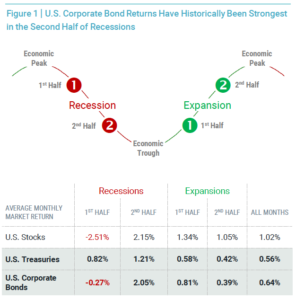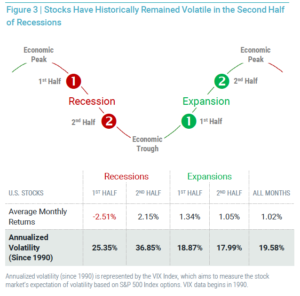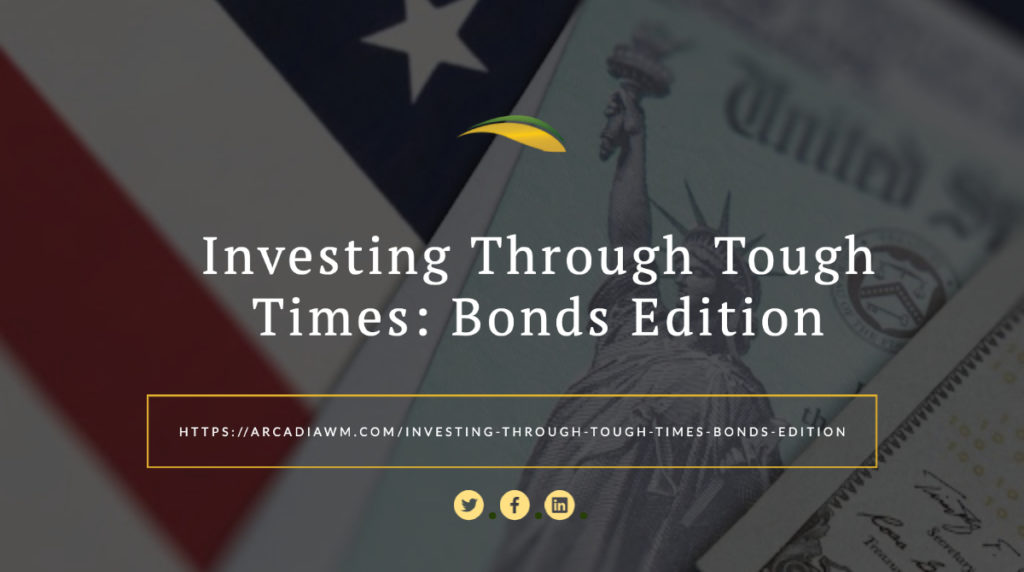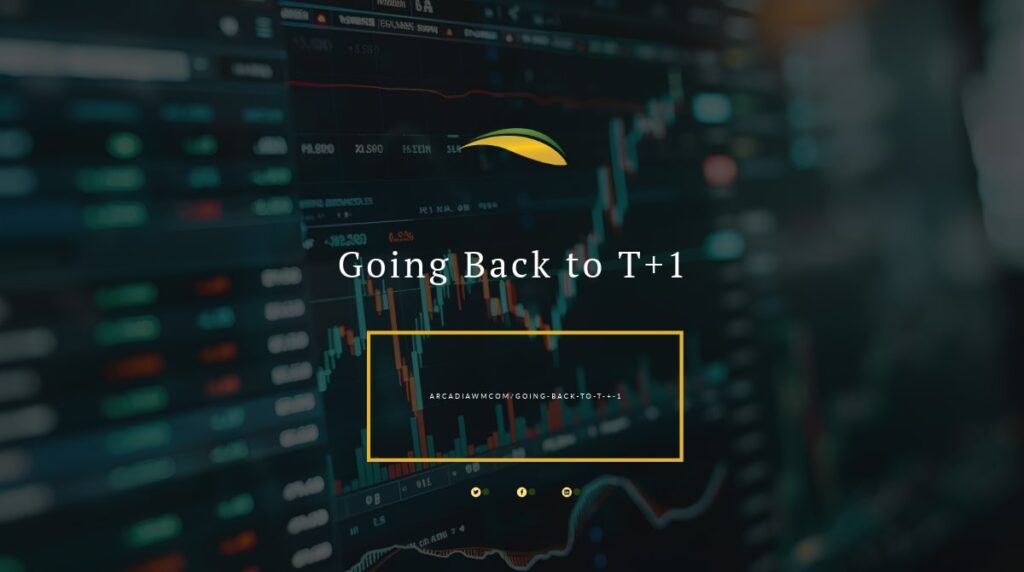In September, we reported on the returns of U.S. stocks during economic business cycles of the past 50 years. There’s reason to believe the U.S. is currently facing a slowdown induced by higher interest rates (i.e., a slowdown in consumer spending) despite positive gross domestic product (GDP) growth during the last quarter following two quarters of negative growth.
The strength of this slowdown is not known, as with recessions whose start and end dates are not identified until well after the fact when the National Bureau of Economic Research (NBER) has sufficient data to make a clear judgment. But we can look to the past to understand how stocks have performed historically both during and coming out of periods of economic contraction.
In our September article, we showed that the average monthly return for U.S. stocks during recessions has, on average, been slightly negative and well below their long-term average. What’s driven this result has been significantly negative returns during the first half of recessions. U.S. stocks have actually experienced strongly positive average returns in the second half of recessions as the economy shows signs of recovery, leading into a period of economic expansion.
While there is no guarantee of what’s to come, these results seem to offer some reason for optimism for those invested in stocks today. But given that many investor portfolios hold a mix of stocks and bonds, this article examines how bonds have performed historically during past recessions and expansions. We also look at volatility during past business cycles, which highlights the need to be ready for bumps in the road even when a recovery is in sight.
What Does a Recession Mean for Bond Returns?
As for stocks, it’s also been a tough year for bond investors. While most U.S. bond sectors have outperformed the broad U.S. stock market, most have still seen losses year to date. U.S. Treasuries and U.S. corporate bonds have experienced steep drawdowns, but there’s no denying the pain has been greater for corporate bondholders.
 So, how have bonds performed during and after recessions historically? Figure 1 presents average monthly returns for Treasuries and corporate bonds during the first and second halves of recessions and expansions over the past 50 years as defined by the NBER. For comparison, we added this data to our prior results for U.S. stocks.
So, how have bonds performed during and after recessions historically? Figure 1 presents average monthly returns for Treasuries and corporate bonds during the first and second halves of recessions and expansions over the past 50 years as defined by the NBER. For comparison, we added this data to our prior results for U.S. stocks.
The data show that U.S. corporates have historically exhibited similar patterns to equities throughout past business cycles. Like stocks, the weakest returns for corporates have come during the first half of recessions, followed by strong returns in the second half. And as true for stocks, above-average returns for corporates have also historically carried into the first half of expansions.
U.S. Treasuries have similarly experienced above-average returns in the second half of recessions, but in the first half of expansions, results have been muted and near their long-term average. The notable difference for Treasuries relative to corporate bonds and stocks comes in the first half of recessions. When U.S. stocks and corporate bonds have historically performed the worst, Treasuries have delivered returns above their long-term average.
What can we take away from these results? First, when markets are pricing in a slowdown in the early days of a recession, risky assets are expected to do worse than assets with stronger backing, as in the case of Treasuries secured by the strength of the U.S. government. Then, as prices incorporate information during tough times, risk premiums in the bond market tend to increase. The difference in yields of corporate bonds versus Treasuries, also known as the credit spread, often becomes wider, and the expected returns of corporate bonds become more attractive.
As shown in Figure 2, looking at the U.S. Treasury and corporate bond yield curves today versus the end of 2021, we can see these dynamics at play. Yields for U.S. Treasuries and BBB-rated corporates have increased significantly since the end of last year. Still, we also see that the difference in yield (or credit spread) between Treasuries and corporates has increased.

Today, 10-year BBB-rated corporate bonds are yielding more than 2 percentage points above that of 10-year Treasuries and up about 1 percentage point from the end of last year.
Another notable observation is that the Treasury curve is inverted today in intermediate maturities, meaning shorter-maturity Treasury bonds (e.g., 2- year maturity) are yielding more than longer maturities (e.g., 10-year maturity). This tells us something about expected returns.
While holding bonds across the maturity spectrum can offer diversification benefits within a broader bond portfolio, investors may also improve expected returns within Treasuries by allocating more weight to higher-yielding short-maturity bonds and less weight to longer-maturity bonds offering lower yields.
A Treasury market index, for example, which offers a snapshot of the current market, will hold the distribution of Treasuries based on bonds outstanding, failing to account for these differences in expected returns.
In contrast to Treasuries, corporate bond yield curves are upwardly sloped. While corporate bonds offer higher yields than Treasuries, there are also generally higher yields today within corporates as you go out the maturity spectrum.
While investors have likely been disappointed by bond returns to date in 2022, the upside is that as bond prices have gone down, expected returns have gone up. With increasing risk premiums, common during the early stages of recessions, the rise in expected returns has been even greater for corporate bonds.
The risk for investors now considering jumping out of fixed income or shifting weight from corporates in favor of Treasuries is missing out on the higher returns historically seen for corporates in the later stages of recessions when the market begins to incorporate better news into prices and the recovery begins.
Understanding Volatility in Tough Times
 It’s also useful for investors to understand that while markets have recovered from many downturns in the past, it’s neither clear when a recovery begins nor guaranteed that it will be a smooth ride when it does. Most would expect market volatility to be high during the tough times. Still, an examination of the historical volatility data shown in Figure 3 reveals that stocks tended to remain volatile even in the second half of recessions when both stocks and bonds have enjoyed well-above-average returns.
It’s also useful for investors to understand that while markets have recovered from many downturns in the past, it’s neither clear when a recovery begins nor guaranteed that it will be a smooth ride when it does. Most would expect market volatility to be high during the tough times. Still, an examination of the historical volatility data shown in Figure 3 reveals that stocks tended to remain volatile even in the second half of recessions when both stocks and bonds have enjoyed well-above-average returns.
This tells us that good times might not always feel so good. This is another reason we believe investors are best served by setting a plan and staying the course through the good and the bad. So, buckle up and stay focused on the destination.
Download a PDF of this article
Download the October 2022 Market Review
This article was provided by Avantis Investors and we have been given permission to share this information with our clients and potential clients.







